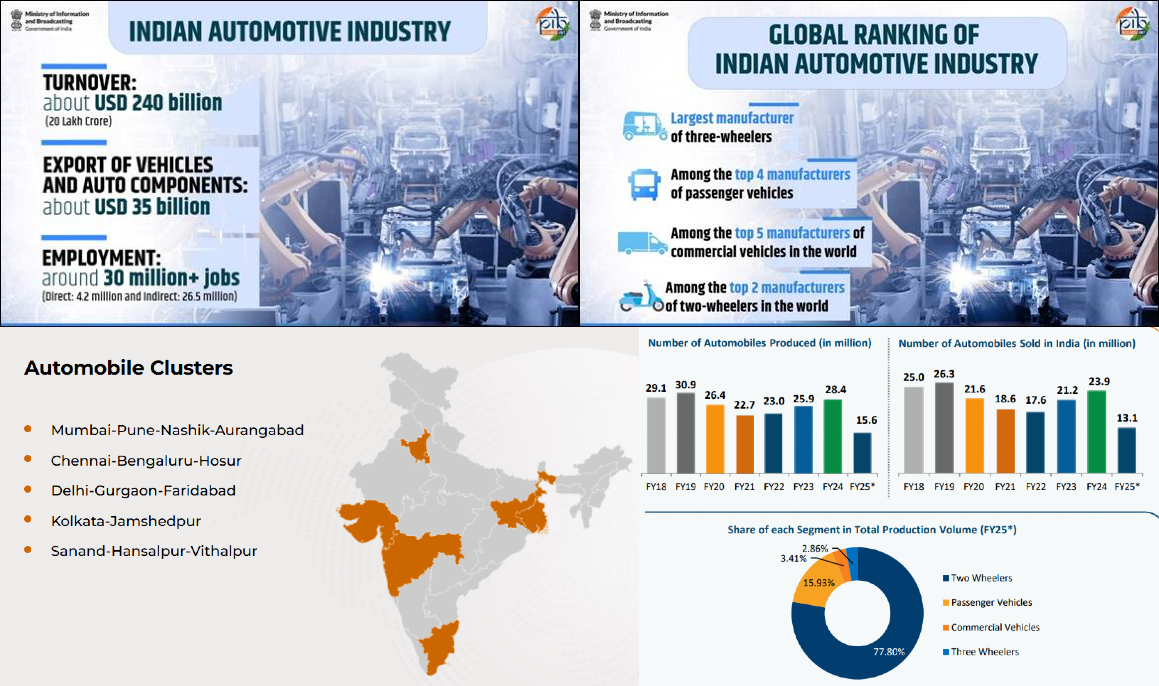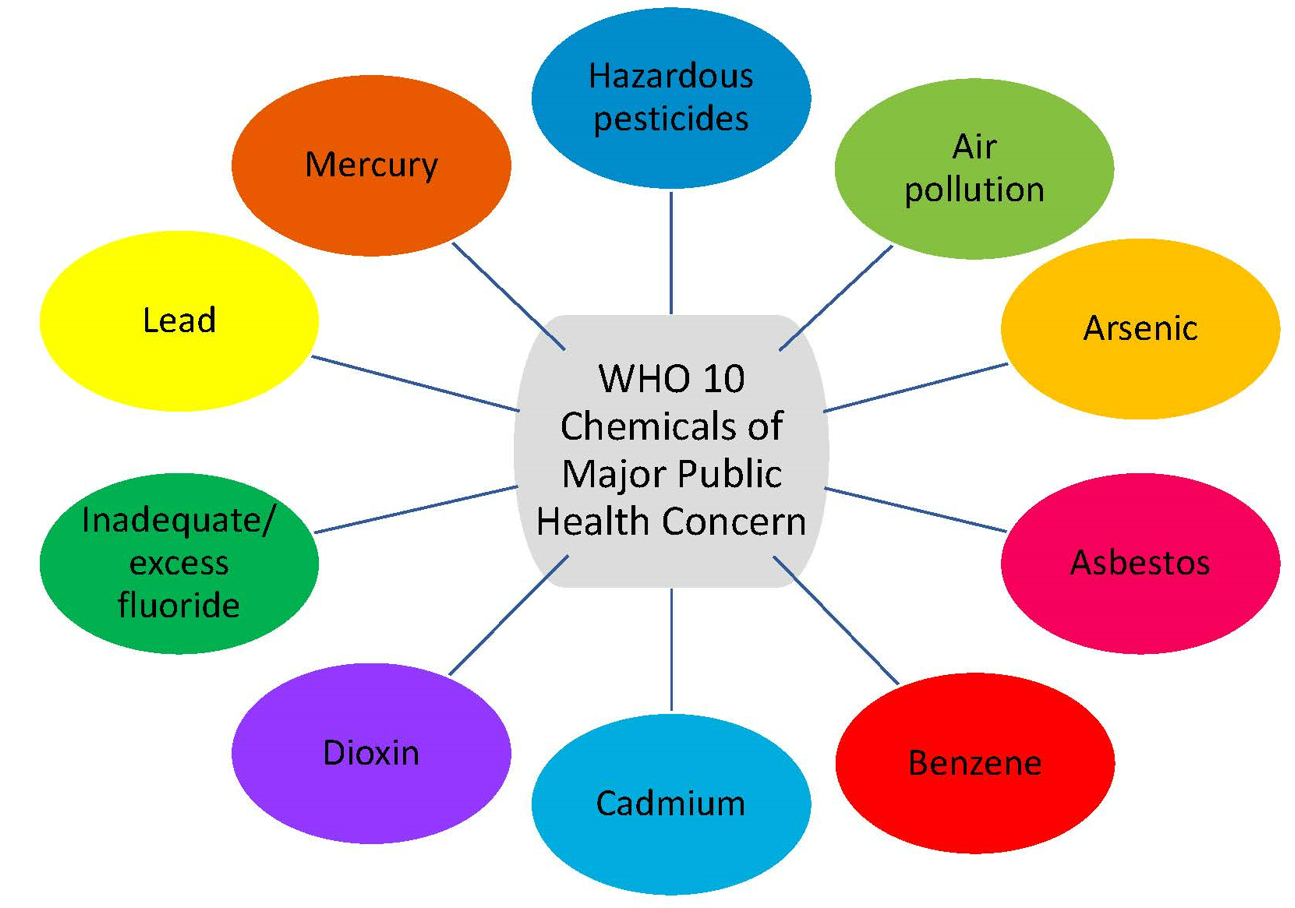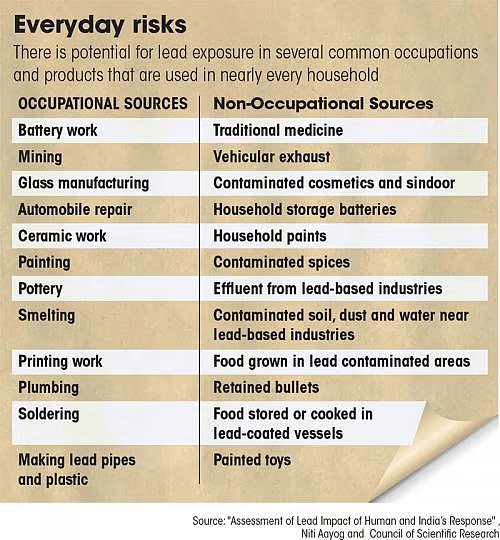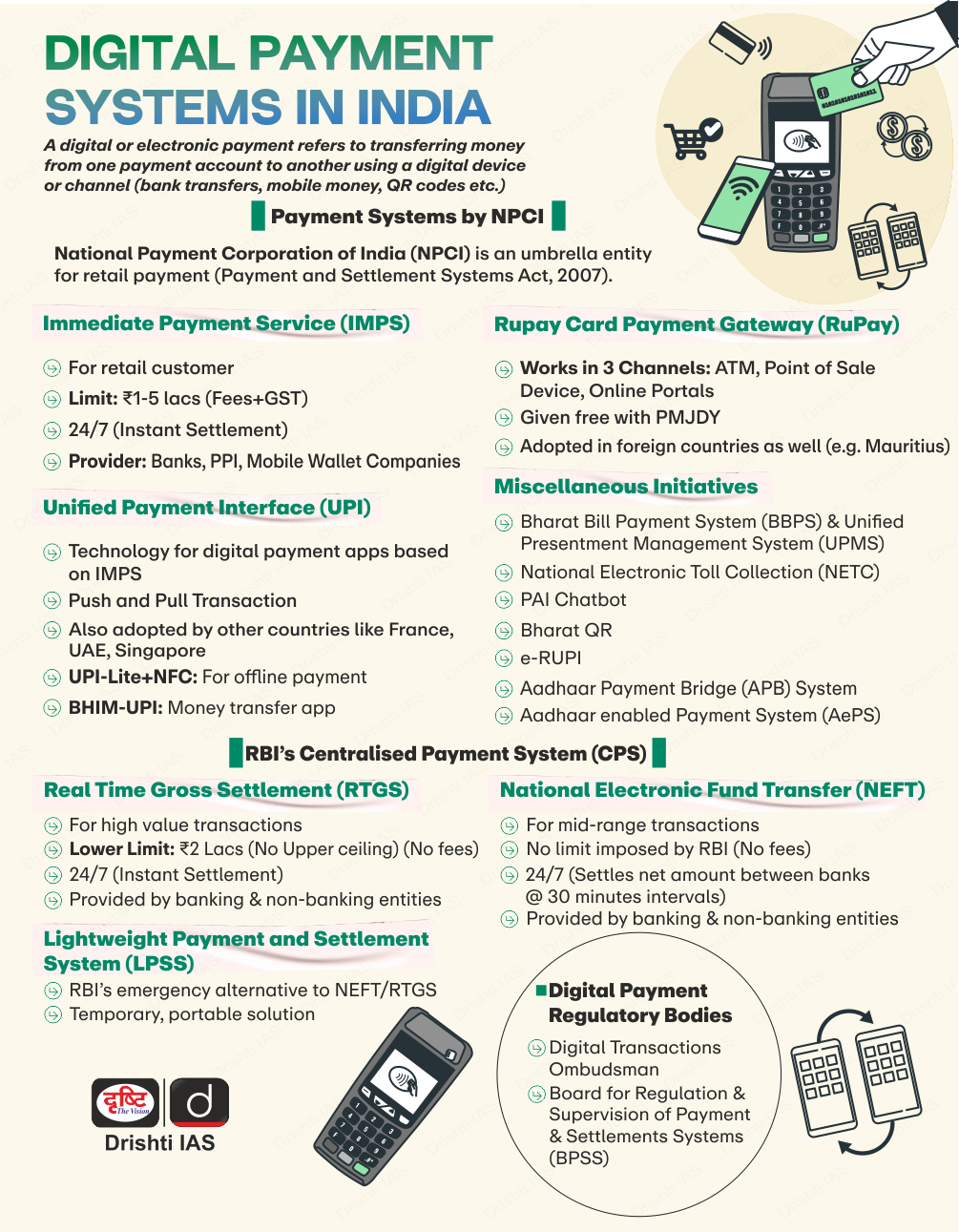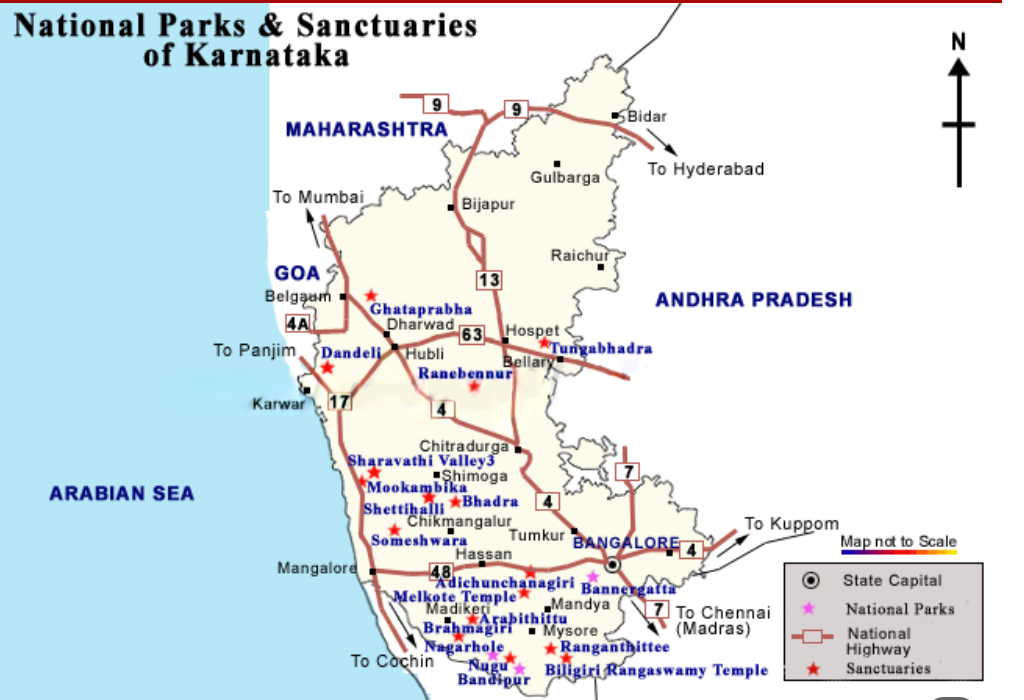Indian Economy
India’s Automobile Sector
For Prelims: Make in India, Foreign Direct Investment, China Plus One, PM e-Bus Sewa, FAME-II
For Mains: Development of the Automobile Sector in India, Challenges and Opportunities in EV Adoption in India
Why in News?
India’s automobile sector under ‘Make in India’ initiative has witnessed record growth in 2023-24, with total vehicle production reaching 28 million units the sector is transforming into a global manufacturing hub, especially for Electric Vehicles (EVs).
What is the Growth Trajectory of India’s Automobile Sector?
- Early Liberalization (Post-1991): The automobile industry was de-licensed in 1991, and subsequent opening up for 100% Foreign Direct Investment (FDI) via the automatic route.
- This opened doors for global manufacturers like Suzuki, Hyundai, and Honda to set up production units in India.
- Production Surge: Vehicle production increased from 2 million units (1991-92) to 28 million (2023-24).
- Contribution to Economy: India's automotive industry has a USD 240 billion turnover, the sector contributes approximately 6% to India’s GDP and supports about 30 million jobs (4.2 million direct and 26.5 million indirect).
- Auto Component Industry: India's auto components industry contributes 2.3% to GDP and directly employs 1.5 million people.
- In FY24, the industry's turnover reached Rs. 6.14 lakh crore (USD 74.1 billion), with 54% of supplies catering to domestic original equipment manufacturers and 18% to exports.
- Growing at a Compound Annual Growth Rate (CAGR) of 8.63% (FY16-FY24), exports stood at USD 21.2 billion in FY24 and are projected to reach USD 30 billion by 2026.
- Electric Vehicle Push: EV registrations crossed 4.4 million by August 2024. The EV market penetration stood at 6.6%.
- Trade:
- Export Expansion: Exports touched 4.5 million units in FY24. India's auto component exports are highest to Europe, North America and Asia.
- Imports: The auto component industry exported USD 21.2 billion and imported USD 20.9 billion worth of components during 2023-24, resulting in a trade surplus of USD 300 million.
- FDI and Investments: India attracted USD 36 billion in FDI (2020-2024), and by FY28, the Indian auto industry plans a USD 7 billion investment to localize electric motors and automatic transmissions, reducing imports and leveraging the "China Plus One" strategy.
What are the Key Auto Sector Initiatives Under Make in India?
- Schemes:
- FAME-II (Faster Adoption and Manufacturing of Hybrid & Electric Vehicles) supports EV adoption with 16.15 lakh EVs incentivized and 10,985 charging stations sanctioned.
- PLI-Auto (Production Linked Incentive for Auto & Components) promotes Advanced Automotive Technology (AAT), including EVs & hydrogen fuel-cell components.
- PLI-ACC (Advanced Chemistry Cell Battery Manufacturing) aims for a 50 Gigawatt hours (GWh) battery manufacturing ecosystem (40 GWh allocated to four firms)
- PM Electric Drive Revolution in Innovative Vehicle Enhancement (2024-2026) supports EVs, e-trucks, e-buses, and charging infrastructure.
- The PM e-Bus Sewa Scheme (FY 2024-29) targets deployment of over 38,000 e-buses.
- Policy Measures: Ministry of Finance reduced GST on EVs from 12% to 5%, and Ministry of Housing & Urban Affairs amended Model Building Bye Laws, 2016 to mandate EV charging stations in private and commercial buildings.
What are the Challenges to India’s Automobile Sector?
- Import Dependency: India relies on imports for key EV components like lithium-ion cells and semiconductors, making costs and supply vulnerable to global disruptions, limiting full self-reliance.
- Limited EV Penetration: India’s EV penetration remains low compared to 12% globally and 30% in China. Additionally, battery and vehicle costs remain high despite GST reduction.
- Limited charging infrastructure, especially in tier-2/3 cities and rural areas, along with range anxiety, hinders widespread adoption despite projections of 20% penetration by FY30.
- Skilled Workforce Shortage: Despite a large job market, the industry lacks skilled workers in automation, fuel cells, and hydrogen tech, crucial for sustainable mobility.
- Stricter Emission Norms: The upcoming Corporate Average Fuel Efficiency (CAFE III & IV) standards (2027-2032) will enforce stricter carbon emission limits, pushing automakers to adopt costly technology upgrades.
- This will likely increase internal combustion engine (ICE) vehicle prices as manufacturers invest in cleaner technologies.
- Shared Mobility & Public Transport: Ride-sharing apps and improved public transport options reduce car ownership demand, affecting vehicle sales.
How Can India Accelerate Its Automotive Growth and Sustainability?
- Localization of Auto Components: Accelerate domestic production of rare earths and lithium by exploring reserves like those in Jammu & Kashmir through the Ministry of Mines' National Critical Mineral Mission.
- Scale up Infrastructure: As recommended by NITI Aayog Integrate EV charging infra with city planning, especially in smart cities and urban transport nodes.
- Create Green Mobility Credit Guarantee Funds to support MSMEs and startups in the EV supply chain.
- Foster Circular Economy: Implement the Battery Swapping Framework, as recommended by NITI Aayog.
- Adopt Green Logistics Policies promoting EV fleets in last-mile delivery, building on Logistics Efficiency Enhancement Program (LEEP).
- Policy Harmonization: Streamline EV policies across States and UTs to align with National Electric Mobility Mission Plan targets (achieve 6-7 million sales of hybrid and EVs year on year from 2020 onwards).
- Digitize regulatory approvals using the National Single Window System (NSWS) for ease of doing business.
- Transition from ICVs to EVs: Support CAFE III & IV with financial and technological assistance, especially for MSMEs.
- Address job displacement in the ICV ecosystem through targeted re-skilling under the Skill India Mission and National Apprenticeship Promotion Scheme.
- Align the Vehicle Scrappage Policy with the EV transition by incentivizing the retirement of older ICVs and providing linked rebates for EV purchase.
|
Drishti Mains Question: Analyze the role of the ‘Make in India’ initiative in transforming India into a global automobile manufacturing hub. |
UPSC Civil Services Examination, Previous Year Questions (PYQs)
Prelims
Q. What is/are the recent policy initiative(s)of Government of India to promote the growth of the manufacturing sector? (2012)
- Setting up of National Investment and Manufacturing Zones
- Providing the benefit of ‘single window clearance’
- Establishing the Technology Acquisition and Development Fund
Select the correct answer using the codes given below:
(a) 1 only
(b) 2 and 3 only
(c) 1 and 3 only
(d) 1, 2 and 3
Ans: (d)
Mains
Q. “Success of ‘Make in India’ program depends on the success of ‘Skill India’ programme and radical labour reforms.” Discuss with logical arguments. (2019)
Q. How is efficient and affordable urban mass transport key to the rapid economic development in India? (2019)


Indian Polity
Indian and US Courts on Contempt
For Prelims: Contempt of Court, Supreme Court (SC), Chief Justice of India (CJI), Contempt of Courts Act, 1971, High Court, District Court.
For Mains: Comparison of the Indian Constitution with Other Countries, Difference in Contempt Proceedings of US and India, Contempt of Court in Indian Judiciary
Why in News?
The US President’s possible defiance of a US district court ruling on withholding foreign aid highlights tensions between the judiciary and executive, raising concerns over separation of powers and possible contempt proceedings.
- This situation brings into focus how courts in different democratic systems enforce compliance with judicial orders, particularly in the US and India.
Structure and Jurisdiction of the US and Indian Courts
- 3 Level Court System: The US federal court system has 3 levels: District courts (trial courts), Circuit courts (appellate courts), and the Supreme Court (final appellate authority).
- India also has a 3-tier system with District Courts at the bottom, followed by High Courts and then Supreme Court, as the highest court of appeal.
- Jurisdiction & Structure: Federal courts handle cases authorized by the US Constitution or federal statutes.
- District Courts handle civil and criminal trials and their judges serve for life.
- Circuit Courts hear appeals from district courts and a panel of 3 judges review cases.
- The Supreme Court is the highest court, hearing appeals on constitutional and federal matters, with discretionary jurisdiction through writs of certiorari.
- In India, Indian courts handle cases under the Constitution, IPC (Bharatiya Nyaya Sanhita), CrPC (Bharatiya Nagarik Suraksha Sanhita), and state laws.
- Jurisdiction of US Federal and Indian Supreme Court: The Indian Supreme Court has a wider jurisdiction than the US Federal Court, with exclusive original jurisdiction (Article 131) over disputes between the Union and States and an advisory jurisdiction (Article 143) allowing the President to seek legal opinions on matters of public importance, which is absent in the US system.
- Additionally, India's Supreme Court has broader appellate powers, judicial review, and allows Public Interest Litigation (PIL), making it more accessible and influential.
How do Contempt Powers Differ in India and the US Courts?
- About: Contempt of court is a legal mechanism to protect the judiciary from attacks or unwarranted criticism, and to punish those who undermine its authority.
- Types of Contempt:
- In the US Court, there are 2 types of contempt: Civil contempt (non-compliance with orders), Criminal contempt (obstruction of justice, defiance).
- Civil contempt in the US can be reversed upon compliance, while criminal contempt is stricter but pardonable by the president.
- Courts have penalized officials for contempt, but never a sitting President.
- In Indian Court, there are also 2 types of contempt: Civil contempt (disobedience of court orders), Criminal contempt (scandalizing the court, obstructing justice).
- In case of India, contempt proceedings can be initiated either by the court itself (suo moto) or by the individual's petition with the prior permission of the Attorney General (AG).
- In the US Court, there are 2 types of contempt: Civil contempt (non-compliance with orders), Criminal contempt (obstruction of justice, defiance).
- Legal Provisions:
- In the US, the Judiciary Act, 1789 empowers all courts to enforce orders through contempt powers, sanctions, and legal mechanisms.
- In India, Article 129 empowers the Supreme Court to punish contempt of itself, while Article 215 grants the same power to High Courts, which also hold the authority to punish contempt of subordinate courts.
- The Contempt of Courts Act (1971) empowers courts to enforce orders through contempt proceedings and decrees.
- Exception: A person is not guilty of contempt for publishing a fair comment on the merits of a case that has been heard and finally decided.
- Courts' Contempt Power & Enforcement: Federal courts in the US ensure compliance through contempt proceedings and attorney sanctions.
- In India, Courts ensure compliance through contempt proceedings.
Compliance, Penalties & Sovereign Immunity of Officials
- In the US, Judges prefer negotiation as sovereign immunity limits penalties on officials. They rarely impose financial penalties or jail time on federal officials.
- In the US, sovereign immunity is strong, preventing lawsuits against the government without its consent, and qualified immunity protects officials from personal liability unless they violate constitutional rights.
- The US Constitution requires compliance with court orders. In extreme cases, non-compliance occurs when the government acknowledges legality but still refuses to comply. Eg. During the Civil War, Abraham Lincoln defied a court order in the John Merryman case (detained without charge), even though he recognized its legality.
- US judges avoid direct confrontations over court orders and prefer modifying demands to ensure compliance.
- Indian courts have punitive authority, including fines, imprisonment, and direct summoning of government officials.
- Under the Code of Civil Procedure (CrPC), courts have provisions for execution of decrees and orders, including attachment of property and arrest in cases of deliberate non-compliance.
- In India, sovereign immunity (rooted in Article 300) exists but is weaker, allowing lawsuits against the government in various cases.
- Officials do not have blanket immunity and can be held personally accountable. Indian courts have stronger contempt powers, enabling them to fine, summon, or jail officials for non-compliance.
- Judicial Review:
- US Courts interpret laws but cannot strike down executive actions easily.
- In India, Judicial review is well-established, allowing courts to strike down unconstitutional actions (e.g., Keshavananda Bharati case, 1973).
Conclusion
While both the US and India grant their judiciary significant powers to enforce court orders, India's system includes broader constitutional provisions. The US relies heavily on its contempt powers and federal enforcement agencies. Despite differences, both nations uphold the principle that judicial decisions must be obeyed, ensuring the rule of law prevails.
UPSC Civil Services Examination, Previous Year Questions (PYQ)
Q. Consider the following statements: (2022)
- Pursuant to the report of H.N. Sanyal Committee, the Contempt of Courts Act, 1971 was passed.
- The Constitution of India empowers the Supreme Court and the High Courts to punish for contempt of themselves.
- The Constitution of India defines Civil Contempt and Criminal Contempt.
- In India, the Parliament is vested with the powers to make laws on Contempt of Court.
Which of the statements given above is/are correct?
(a) 1 and 2 only
(b) 1, 2 and 4
(c) 3 and 4 only
(d) 3 only
Ans: (b)


Biodiversity & Environment
Lead Poisoning
Prelims: Lead, Lead Poisoning, Plumbism, Saturism, Anaemia, Heavy Metal, United Nations Environment Programme, Central Pollution Control Board (CPCB).
Mains: Environmental Pollution & Degradation, Lead Poisoning and related concerns
Why in News?
Lead poisoning remains a significant but overlooked public health crisis in India, particularly affecting children. While multiple laws regulate lead contamination across sectors, the absence of a comprehensive legal framework for its prevention and mitigation hinders effective enforcement and policy coherence.
Lead
- Lead is a toxic, naturally occurring heavy metal characterized by its softness, malleability, and bluish-white luster, with no safe level of exposure identified.
- WHO identifies lead as one of 10 chemicals of major public health concern.
- In 2021, WHO issued guidelines recommending that individuals with blood lead levels ≥5 µg/dL should be assessed for exposure sources, and steps taken to eliminate them.
- Lead-based paint continues to be a major global source of lead exposure. WHO and UNEP’s Global Alliance to Eliminate Lead Paint urges countries to implement legal restrictions; however, as of January 2024, only 48% have enacted such laws.
What is Lead Poisoning?
- About: Lead poisoning (also known as Plumbism and Saturism) occurs when lead accumulates in the body over time, typically over months or years, leading to toxic effects.
- Status of Lead Poisoning: Lead is poisoning 1/3 of all children globally.
- A 2020 UNICEF-Pure Earth report found that half of India's children have high blood lead levels (BLL). About 275 million children exceed the WHO’s safe limit (5 μg/dL), and 64.3 million have even higher levels (above 10 μg/dL).
- CSIR-NITI Aayog Report: 23 states exceed the recommended 5 µg/dL BLL limit.
- Approximately 5% of India’s GDP loss due to lead poisoning.
- Sources:
- Symptoms & Effects: Symptoms include fatigue, abdominal pain, nausea, diarrhoea, loss of appetite, anemia, muscle weakness, and a characteristic dark line along the gums.
What is Mercury Poisoning?Click Here to Read: Mercury Poisoning |
What are the Policy Measures to Combat Lead Poisoning in India?
- Existing Policy Measures/ Legal Provisions:
- Ban on Leaded Petrol (2000): India phased out leaded petrol, reducing airborne lead pollution, health risks, and environmental damage. This transition also helped reduce engine knocking, improving vehicle efficiency and engine longevity, aligning with global efforts for cleaner fuel and better air quality.
|
Regulations |
Provisions |
|
Environment Protection Act, 1986 |
It empowers the central government (CPCB) to regulate lead contamination by setting permissible limits for effluents and pollutants. |
|
Factories Act, 1948 |
It ensures worker health and safety, indirectly addressing lead poisoning in industries using lead. Chapter III focuses on worker safety, welfare, and hygiene.
|
|
The Code of Practice for Water Supply in Buildings, 1957 |
It prohibits lead pipes for domestic water supply, setting a 10 µg/L lead limit in water. However, it permits lead piping for flushing and overflow systems.
|
|
Insecticides Act, 1968 |
It regulates the import, manufacture, sale, and use of insecticides for safety and efficacy.
|
|
Food Safety and Standards Act, 2006 |
It empowers FSSAI to regulate food safety and set lead limits in food (e.g.,turmeric (10), leafy vegetables (0.3), pulses (0.2), sugar (5.0), infant Food (0.2), etc.) and drinking water (0.01 mg/L as per BIS).
|
|
Hazardous Waste Management Rules, 2016 |
It classifies lead-containing waste and regulates its storage, treatment, and disposal, requiring industries to obtain SPCB/PCC authorization.
|
|
Drugs and Cosmetics Act, 1940 |
These set a lead limit of 20 ppm in cosmetics, mandating compliance for manufacturers and importers with proper ingredient labeling. |
|
The Child Labour Act, 1986 |
It helps mitigate lead poisoning by prohibiting child labor in hazardous environments. |
|
Bureau of Indian Standards Act, 2016 |
It designates BIS as India's National Standards Body, ensuring standardization, marking, and quality certification of goods.
|
What are the Challenges to Implementation in Lead Regulations?
- Lead in Insecticides: The Insecticides Act, 1968, still lists Lead Arsenate as an insecticide, despite its ban under the 2019 list of prohibited pesticides by the Ministry of Agriculture due to health and environmental risks.
- Lead in Food Products: FSSAI has banned Lead Chromate in turmeric but allows lead content up to 10 ppm, creating a regulatory loophole that permits trace lead contamination despite the ban.
- Lead in Paints: The 2016 rules limit lead in new paints but do not address existing lead-based paint in homes.
- Water Contamination: Weak enforcement of the Code of Practice for Water Supply in Buildings (1957) and Lead Stabilizers in PVC Pipes Rules (2021).
Way Forward
- Stronger Legal Framework: Introduce a dedicated set of rules under the Environment Protection Act (EPA), 1986, regulating lead production, recycling, and disposal to ensure comprehensive legal coverage.
- Establish a Safe Blood Lead Level (BLL): Define and implement a national threshold for BLL in line with WHO recommendations to guide policy interventions.
- Occupational Safety Standards: Adopt global best practices such as US’ Occupational Safety and Health Administration (OSHA) regulations and the UK’s Control of Lead at Work Regulations (2002) to protect workers in lead-related industries.
- Stricter Enforcement: Establish clear penalties for non-compliance, particularly in industries, water supply, and toy manufacturing, aligning with EU Toy Safety Directive standards.
- Public Awareness & Market Incentives: Promote lead-free products through tax incentives and large-scale public awareness campaigns to encourage safer alternatives.
Conclusion
To combat lead poisoning effectively, a comprehensive regulatory framework, stricter enforcement, and public awareness initiatives are essential. Given its severe health risks, lead poisoning must be treated as a top public health priority in India.
UPSC Civil Services Examination, Previous Year Questions (PYQs)
Q. Lead, ingested or inhaled, is a health hazard. After the addition of lead to petrol has been banned, what still are the sources of lead poisoning? (2012)
- Smelting units
- Pens and pencils
- Paints
- Hair oils and cosmetics
Select the correct answer using the codes given below:
(a) 1, 2 and 3 only
(b) 1 and 3 only
(c) 2 and 4 only
(d) 1, 2, 3 and 4
Ans: (b)


Facts for UPSC Mains
LPG Subsidy Initiatives in India
Why in News?
The Pratyaksh Hastantarit Labh (PAHAL) Direct Benefit Transfer (DBT) scheme and the ‘Give It Up’ campaign have completed a decade since their nationwide rollout.
- Alongside these, the government also launched the Pradhan Mantri Ujjwala Yojana (PMUY) in 2016 to expand Liquefied Petroleum Gas (LPG) coverage, especially for economically weaker households.
What is the PAHAL DBT Scheme?
- About: The PAHAL DBT Scheme launched nationwide in 2015, is an initiative by the Ministry of Petroleum & Natural Gas to ensure the direct transfer of LPG subsidies to consumers’ bank accounts.
- The scheme aims to eliminate leakages, prevent duplicate connections, and enhance transparency in subsidy distribution.
- Working: LPG cylinders are sold at market price, and the subsidy amount is directly transferred to consumers’ bank accounts.
- Consumers receive the subsidy through two modes Aadhaar Transfer Compliant Mode and Bank Transfer Compliant Mode (subsidy credited to the registered bank account without Aadhaar linkage).
- Objectives: Aims to eliminate middlemen and fake LPG connections, ensuring benefits reach genuine consumers.
- Encourages beneficiaries to open bank accounts, integrating them into the formal financial system.
- Achievements: As of 2024, over 30.19 crore LPG consumers are enrolled under PAHAL. The scheme has saved the government over Rs 1.5 lakh crore by reducing subsidy wastage and removing ineligible consumers.
- Aadhaar-based authentication helped remove duplicate beneficiaries and fake or fraudulent LPG connections from the system.
What is the Give It Up Campaign?
- About: Give It Up Campaign launched in 2015, by Prime Minister Narendra Modi at the ‘Urja Sangam’ global energy summit.
- It encouraged well-off LPG consumers to voluntarily surrender their subsidies, allowing the government to redirect funds to the poor.
- Impact: The campaign saw 10 million give up subsidies in the first year, but slowed to 11.5 million by 2025.
What is the Pradhan Mantri Ujjwala Yojana?
- About: PMUY aims to provide deposit-free LPG connections to adult women from economically weaker households.
- The scheme promotes clean cooking fuel, reduces health risks from indoor pollution, and decreases dependence on traditional fuels.
- Beneficiaries receive Rs 2,200 per 14.2 kg connection and Rs 1,300 per 5 kg connection (from FY 2023-24).
- Additionally, interest-free loans are available for purchasing gas stoves, ensuring wider accessibility.
- Implementation and Expansion:
- Phase 1 (2016-2019): Initial target of 80 million LPG connections, achieved by September 2019.
- Phase 2 - Ujjwala 2.0 (2021-2022): Additional 16 million connections provided by December 2022.
- Phase 3 (2023-2026): Government approved 7.5 million more connections, target met by July 2024.
- As of January 2025, a total of 103.3 million PMUY connections have been issued across India.
Why is LPG Adoption Still Limited Despite Widespread Access?
- High Recurring Cost of Refills: Even with deposit-free connections, the cost of refilling LPG cylinders (~ Rs 1,100/cylinder) is prohibitive for many BPL families.
- According to the Petroleum Planning & Analysis Cell (PPAC, 2016), 83% of respondents cited high refill cost as a key deterrent.
- Although PMUY connections are free, 86% of households struggle with the cost of stoves, hoses, and regulators.
- While the government provides a refill subsidy, it still leaves a substantial cost burden for poor households to maintain a regular LPG connection.
- Low Refill Rates Among Beneficiaries PMUY households refill on average 3.95 times/year (2023-24), compared to 6.5 times/year for non-PMUY users.
- The maximum permitted is 12 subsidised cylinders/year, highlighting underutilisation.
- Availability of Traditional Fuels: Firewood, cow dung, and crop residues are freely available or low-cost, making them preferred options in rural areas.
- Cooking on chulhas (traditional stoves) is deeply entrenched in some regions due to habit and cooking style.
| Read more: Pradhan Mantri Ujjwala Yojana (PMUY) |
|
Drishti Mains Question: Despite widespread access to LPG through PMUY, why do many households continue to rely on traditional fuels? |
UPSC Civil Services Examination, Previous Year Questions (PYQ)
Mains
Q. Access to affordable, reliable, sustainable and modern energy is the sine qua non to achieve Sustainable Development Goals (SDGs).” Comment on the progress made in India in this regard. (2018)


Rapid Fire
Sahyog Portal
X Corp (formerly Twitter) has filed a lawsuit in the High Court against the Indian government, challenging alleged censorship and content regulation through Section 79 of the Information Technology (IT) Act, 2000 and the newly introduced Sahyog portal.
- X argued that content regulation orders be issued only under Section 69A of the IT Act, 2000.
- Sahyog Portal: The Sahyog Portal has been launched by the Ministry of Home Affairs (MHA) to enhance collaboration between government agencies and social media intermediaries for easy compliance and safer cyberspace.
- It streamlines the reporting and removal of unlawful content and facilitates data requests from law enforcement under the IT Act, 2000.
- It integrates authorized agencies (like police) and intermediaries on a single platform, ensuring swift action against illegal digital activities.
- Sections of IT Act:
- Section 69A: It empowers the centre to block public access to online content under specific circumstances to protect national security, sovereignty, and public order.
- Section 79: It grants "safe harbor" protection to online intermediaries, protecting them from liability for third-party content if they act neutrally.
- Under Section 79(3)(b), intermediaries lose this immunity if they fail to act expeditiously on notices regarding illegal content.
| Read More: Information Technology Amendment Rules, 2023 |


Rapid Fire
BHIM 3.0
The NPCI BHIM Services Limited (NBSL), a subsidiary of National Payments Corporation of India (NPCI) has launched Bharat Interface for Money (BHIM) 3.0 app.
- BHIM 3.0: It is an upgraded version of BHIM.
- BHIM Unified Payment Interface (UPI) was launched in 2016 to provide a simple, fast, and secure method for cashless payments using UPI technology.
- It enabled users to send and receive money instantly through mobile phones, without requiring bank account details.
- Key Features of BHIM 3.0:
- BHIM 3.0 has enhanced accessibility and security with support for 15+ languages, low-internet optimization, and improved security features for safer transactions.
- For users, it offers Split Expenses, Spends Analytics, and an Action Needed Assistant (reminders for pending bills) for better expense tracking and financial management.
- For merchants, BHIM Vega offers a seamless in-app payment system, enabling seamless transactions without switching platforms.
- NPCI: NPCI was founded in 2008 by the RBI and Indian Banks' Association under the Payment and Settlement Systems Act, 2007, to oversee and manage retail payments and settlement systems in India.
- NPCI International Payments Ltd. has expanded UPI to 7 countries, including Bhutan, Mauritius, Nepal, Singapore, Sri Lanka, and France with 20 apps like PhonePe, Paytm, and Google Pay supporting international transactions.
| Read More: PayU Gets Approval as Payment Aggregator. |


Rapid Fire
Gold Monetisation Scheme
Based on the performance of the Gold Monetisation Scheme (GMS), the Union Government has decided to discontinue the Medium-Term and Long-Term Government Deposit (MLTGD) components of the scheme. However, banks may continue to offer Short-Term Bank Deposits (STBD).
- Earlier, the government had also discontinued the Sovereign Gold Bonds (SGB).
- GMS: The GMS, which comprises the earlier 'Gold Deposit Scheme' and 'Gold Metal Loan' scheme, was announced on 15th September 2015.
- It aims to decrease the country's long-term dependence on gold imports and mobilize gold held by households and institutions in the formal economy.
- Components of GMS:
- Short Term Bank Deposit (1-3 years) (variable interest rate)
- Medium Term Government Deposit (5-7 years) (2.25% interest rate)
- Long-Term Government Deposit (12 - 15 years) (2.5% interest rate)
- Interest Rate Under GMS: For MLTGD, the rate of interest is decided by the Union Government in consultation with the RBI, whereas for short term deposits, the rate of interest is decided by the banks.
- SGB: The SGB scheme was introduced in 2015 to decrease the demand for physical gold and redirect a portion of domestic savings, which would otherwise be used to buy gold, into financial savings.
- The scheme provides an interest rate of 2.5% on the initial investment, with interest credited semi-annually to the investor's bank account.
| Read More: Gold Monetisation Scheme, Sovereign Gold Bond Scheme, Factors Shaping Global Gold Prices |


Place In News
Bhadra Wildlife Sanctuary and Tiger Reserve
Karnataka has proposed a “soft-release” strategy to manage the escalating human-elephant conflict in Hassan, Chikkamagaluru, and Kodagu districts by gradually rehabilitating captured elephants into the Bhadra Wildlife Sanctuary (BWS).
- Soft-Release Strategy: Elephants will stay in a 20 sq. km enclosure for acclimatization and health checks before their phased release at four designated sites in BWS.
- Bhadra Wildlife Sanctuary: Named after the Bhadra River, it is also known as Muthodi Wildlife Sanctuary.
- It is a Project Tiger reserve, and hosts diverse forests, including Southern Moist Mixed Deciduous Forests, Dry Deciduous Forests, and Shola Forests.
- It also houses the Jagara Giant, Karnataka’s largest 400-year-old teak tree.
- BWS hosts diverse fauna, including tigers, leopards, dholes, gaurs, deer, and elephants. It shelters 250+ bird species like Hornbills, Malabar Trogon, and Hill Myna, many endemic to the Western Ghats.
- The sanctuary currently hosts around 450 elephants, forest officials estimate it can accommodate 200 more elephants.
- It is a Project Tiger reserve, and hosts diverse forests, including Southern Moist Mixed Deciduous Forests, Dry Deciduous Forests, and Shola Forests.
| Read more: Bandipur Tiger Reserve |



